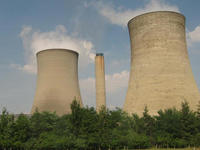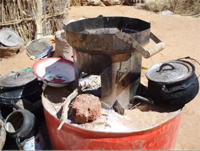-
U.K. nuclear plants are safe: report

The United Kingdom has finalized a review of the implications of the Fukushima disaster for the U.K. nuclear power industry; Dr. Mike Weightman, the author of the review, said that the “U.K. nuclear facilities have no fundamental safety weaknesses”
-
-
Tweeting may help in disasters
Social networks like Twitter cannot help prevent disasters, but can quickly correct misinformation resulting from false rumors, thus preventing possible further loss of lives
-
-
Alabama: students do not need birth certificates to attend school
After thousands of fearful Hispanic students failed to show up for classes on Monday in Alabama, the state’s top education official announced that children would still be allowed to attend even if they did not have birth certificates
-
-
"Burying" FEMA in DHS was "huge structural and operational mistake"
Homeland Security NewsWire’s executive editor Eugene K. Chow recently had the opportunity to interview Aden Hogan Jr., the city manager of Evans, Colorado and the former assistant city manager of Oklahoma City during the 1995 terrorist attack; in their interview, Hogan rates FEMA’s response during the recent spate of natural disasters in the United States, problems the agency has had since it became integrated in DHS, and steps that local governments and residents should be taking to better prepare themselves for major disasters
-
-
Graduate student develops emergency communication Twitter app
A graduate student at the University of Colorado has developed a smartphone app that makes it easier for first responders and emergency personnel to communicate via Twitter during disasters; without a standardized syntax, emergency personnel, affected individuals, information officers, and journalists were having trouble communicating on Twitter
-
-
Australia’s disasters cost insurers $25.6 billion
The series of disasters that struck Australia this year including the Queensland floods, Cyclone Yasi, and the New Zealand earthquake has hit local insurers particularly hard with a combined loss of $25.6 billion
-
-
Safe, efficient cookstoves for earthquake survivors

316,000 people were killed and more than one million made homeless by the 12 January 2010 magnitude 7.0 quake that left the capital city of Port-au-Prince in ruins; many of the displaced Haitians still live in tent cities, where even simple tasks such as cooking are a challenge; scientists hope to find the safest and most energy-efficient way for earthquake survivors to cook
-
-
Evaluating California earthquake forecasts
The Southern California Earthquake Center held a competition among seven different earthquake forecasts; an analysis of the competition shows that earthquake prediction remains an imperfect science, but the best forecasts are about ten times more accurate than a random prediction; the findings should help researchers both develop better earthquake forecasts and improve their tools for assessing those forecasts
-
-
Protecting structures against firebrand attack
NIST engineers have built a device that bellows showers of glowing embers, or firebrands, to test how structures can withstand this destructive aspects of wild fires; in Japan, where the device is now used in a test facility, firebrands are a growing peril that accounts for half of the nation’s ten most costly fires
-
-
Predicting race and ethnicity from irises now possible

Conventional wisdom holds that irises, like fingerprints, are unique to each individual and have little similarities between ethnic groups or gender, but a groundbreaking new study indicates that biometric scanners can actually predict race and gender based on iris texture alone; the study’s findings are important in that it opens new avenues for research that previously were not thought possible
-
-
U.S. intervention hinders disaster recovery, says reinsurance giant
Lloyd’s of London, the largest reinsurer of U.S. risk, said the federal government’s intervention in the insurance market could hinder recovery efforts following natural disasters; “We don’t believe that the U.S. has the balance between industry and government intervention right, you have government intervention in federal and state level, it demonstrates this is not a sustainable way to proceed,” said Lloyds general counsel
-
-
Disaster scams on the rise
In the immediate aftermath of natural disasters, fraudsters have increasingly rushed in to take advantage of the outpouring of charitable donations; speaking on a panel at an international symposium on organized fraud in Australia, the Department of Justice’s deputy chief for strategy and policy in the Fraud Section of the Criminal Division, said scammers had websites for fake charities in place before predicted disasters had even hit
-
-
Connecticut town considers charging centers for power outages
Following Hurricane Irene which left thousands without power up and down the East Coast, a town in Connecticut is considering building several charging stations for residents to power up their hand held electronics during a natural disaster or prolonged power outage
-
-
Georgia shows app that prepares state residents, guides them to safety
New Ready Georgia mobile app uses geo-location to deliver alerts, create emergency plans, and show shelter locations; from up-to-the-minute weather and hazard alerts based on a user’
‘s location, to customizable emergency preparedness checklists, the app combines a set of features not previously available in one mobile application -
-
NIST offers comprehensive risk assessment guidance for federal information systems
NIST has released two new publications dealing with risk assessment; one is the authoritative source of comprehensive risk assessment guidance for federal information systems, the other, an update to a March 2011 publication, focuses exclusively on risk assessments
-
- All
- Regional
- Water
- Biometrics
- Borders/Immig
- Business
- Cybersecurity
- Detection
- Disasters
- Government
- Infrastructure
- International
- Public health
- Public Safety
- Communication interoperabillity
- Emergency services
- Emergency medical services
- Fire
- First response
- IEDs
- Law Enforcement
- Law Enforcement Technology
- Military technology
- Nonlethal weapons
- Nuclear weapons
- Personal protection equipment
- Police
- Notification /alert systems
- Situational awareness
- Weapons systems
- Sci-Tech
- Sector Reports
- Surveillance
- Transportation
Advertising & Marketing: advertise@newswirepubs.com
Editorial: editor@newswirepubs.com
General: info@newswirepubs.com
2010-2011 © News Wire Publications, LLC News Wire Publications, LLC
220 Old Country Road | Suite 200 | Mineola | New York | 11501
Permissions and Policies
Editorial: editor@newswirepubs.com
General: info@newswirepubs.com
2010-2011 © News Wire Publications, LLC News Wire Publications, LLC
220 Old Country Road | Suite 200 | Mineola | New York | 11501
Permissions and Policies
